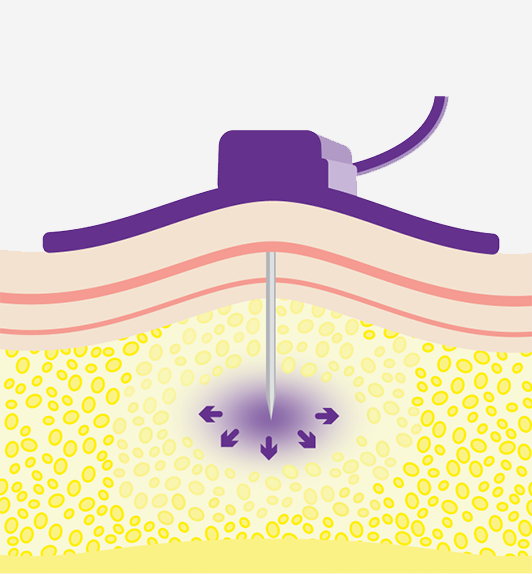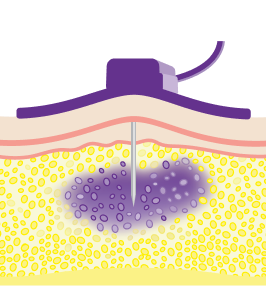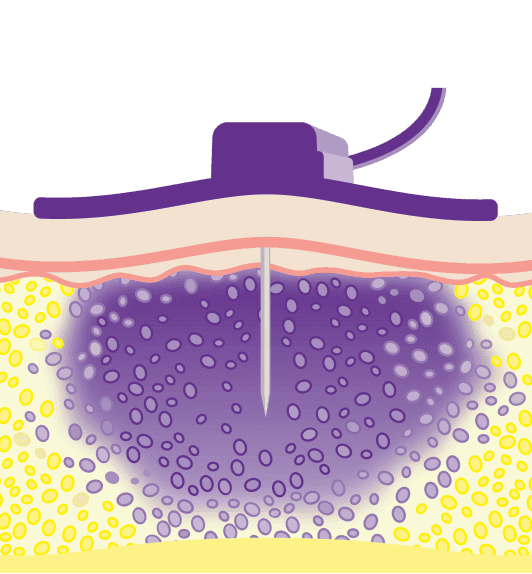unique treatment
component1


HyQvia®: The only once-a-month* SCIG with Recombinant Human Hyaluronidase (Hy)1
The hyaluronidase in HyQvia locally, temporarily, and reversibly modifies the hyaluronan in the subcutaneous tissue, helping increase the dispersion and absorption of IG into the bloodstream, so your patients can receive a full monthly* dose of IG subcutaneously.†
*Every 3 or 4 weeks.
†Over the course of the efficacy and extension trials of HyQvia in ~3.5 years (2959 infusions), there were no clinically observable changes in the skin or the subcutaneous tissue. Permeability of the subcutaneous tissue is restored within 24 to 48 hours.
How hyaluronidase works
Recombinant Human Hyaluronidase in HyQvia makes it different from other immune globulin (IG) treatments by helping increase the dispersion and absorption of IG into the bloodstream.1
It has been shown to locally, temporarily, and reversibly modify the hyaluronan in the subcutaneous tissue, helping increase the dispersion and absorption of IG.1
Permeability of the subcutaneous tissue is restored within 24 to 48 hours.1

The body naturally contains hyaluronan.3
The subQ tissue directly beneath your skin is naturally filled with hyaluronan.

Hyaluronan limits the volume of IG that can be infused.3
Without the Recombinant Human Hyaluronidase (Hy) in HyQvia, hyaluronan would limit the amount of immunoglobulin that can be infused into the subQ tissue.

Hy makes room for a larger volume of IG.3
Hy allows a larger amount of IG to reach the subQ tissue and be absorbed into the bloodstream. That’s why HyQvia can be infused monthly,* which is less frequent than other subQ IG treatments.
subQ=subcutaneous.
*Every 2, 3, or 4 weeks
References
- Van den Bergh PYK, van Doorn PA, Hadden RDM, et al. European Academy of Neurology/Peripheral Nerve Society guideline on diagnosis and treatment of chronic inflammatory demyelinating polyradiculoneuropathy: Report of a joint Task Force-Second revision. J Peripher Nerv Syst. 2021;26(3):242-268. doi:10.1111/jns.12455
- Jolles S, Sewell WA, Misbah SA. Clinical uses of intravenous immunoglobulin. Clin Exp Immunol. 2005;142(1):1-11. doi:10.1111/j.1365-2249.2005.02834.x
- HyQvia. Prescribing information. Takeda Pharmaceuticals U.S.A., Inc.; 2025.
- Elovaara I, Apostolski S, van Doorn P, et al. EFNS guidelines for the use of intravenous immunoglobulin in treatment of neurological diseases: EFNS task force on the use of intravenous immunoglobulin in treatment of neurological diseases. Eur J Neurol. 2008;15(9):893-908. doi:10.1111/j.1468-1331.2008.02246.x
- Dalakas MC. Update on intravenous immunoglobulin in neurology: Modulating neuro-autoimmunity, evolving factors on efficacy and dosing and challenges on stopping chronic IVIg therapy. Neurotherapeutics. 2021;18(4):2397-2418. doi:10.1007/s13311-021-01108-4
- Dalakas MC, Latov N, Kuitwaard K. Intravenous immunoglobulin in chronic inflammatory demyelinating polyradiculoneuropathy (CIDP): mechanisms of action and clinical and genetic considerations. Expert Rev Neurother. 2022;22(11-12):953-962. doi:10.1080/14737175.2022.2169134
- Jacob S, Rajabally YA. Current proposed mechanisms of action of intravenous immunoglobulins in inflammatory neuropathies. Curr Neuropharmacol. 2009;7(4):337-342. doi:10.2174/157015909790031166
- Kohle F, Dalakas MC, Lehmann HC. Repurposing MS immunotherapies for CIDP and other autoimmune neuropathies: unfulfilled promise or efficient strategy?. Ther Adv Neurol Disord. 2023;16:17562864221137129. doi:10.1177/17562864221137129
- Vani J, Elluru S, Negi VS, et al. Role of natural antibodies in immune homeostasis: IVIg perspective. Autoimmun Rev. 2008;7(6):440-444. doi:10.1016/j.autrev.2008.04.011
- Brun S, de Sèze J, Muller S. CIDP: Current treatments and identification of targets for future specific therapeutic intervention. Immuno. 2022;2(1):118-131. doi:10.3390/immuno2010009
- Ozdag Acarli AN, Tuzun E, Sanli E, et al. Disease activity in chronic inflammatory demyelinating polyneuropathy: association between circulating B-cell subsets, cytokine levels, and clinical outcomes. Clin Exp Immunol. 2024;215(1):65-78. doi:10.1093/cei/uxad103
- Mausberg AK, Heininger MK, Meyer Zu Horste G, et al. NK cell markers predict the efficacy of IV immunoglobulins in CIDP. Neurol Neuroimmunol Neuroinflamm. 2020;7(6):e884. doi:10.1212/NXI.0000000000000884

 , and
, and